Lino Tagliapietra Beautiful Style Art Glass Sculpture Dinosaur Murano 15 x 5.5
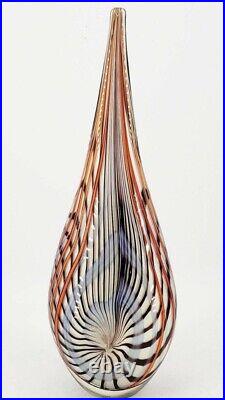
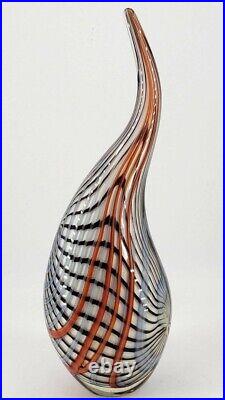


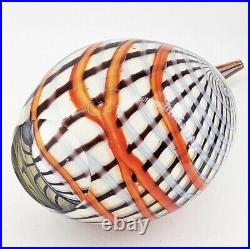

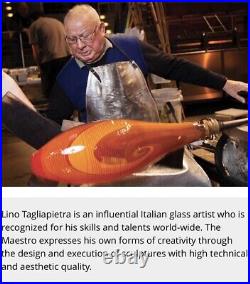
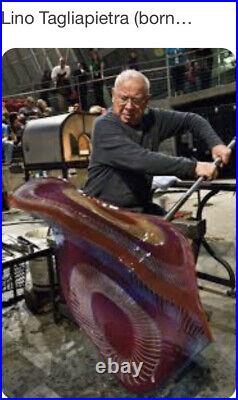
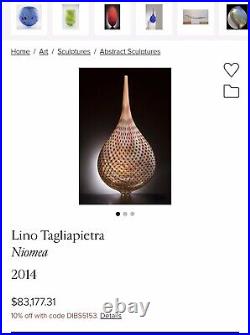
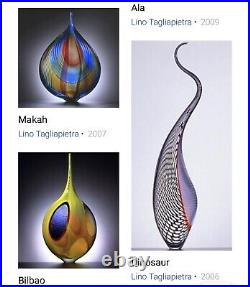

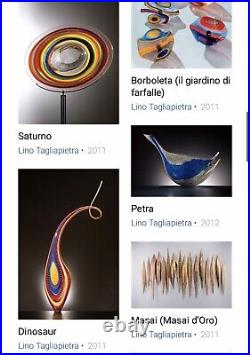

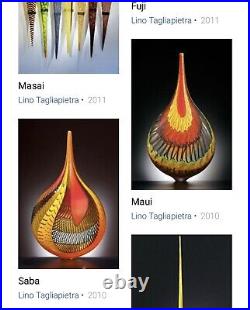




What you see: A Lino Tagliapietra dinosaur, a glass sculpture created at Murano, Italy in 2008. The expert: Suzanne Perrault, partner and co-director of Rago's 20th and 21st century design department. First, how is Lino Tagliapietra's name pronounced?
How prolific is Lino Tagliapietra? He was born in 1934 and just turned 85.He is still working and regularly coming up with new techniques and series. He gives hope to all of us!
When did his "Dinosaur" series start? Why are these pieces called Dinosaurs? Lino can be very creative with how he brands his piece. How well-regarded is the Dinosaur series among his works? Is it among the most sought-after? Lino has done a great many series and continues to invent new ones regularly. Some works also don't have specific names. I'm sure some collectors like the swooping grace of dinosaurs best of everything. Personally, I'm a coldwork lover. Coldwork describes techniques performed on glass at room temperature.My favorite piece we've ever offered was this one because of all the different patterns offered on it. What defines this piece as "small"? How big do his Dinosaurs tend to get?
At 15 inches tall, this is the tiniest I've seen. What qualities make this an "exceptional small Dinosaur, " per the lot notes? It has a lovely, manageable scale. Its surface is also cold-worked in battuto and inciso, which they aren't always.These are both carving patterns on glass, battuto being shorter and squatter, like a hammer mark on metal. Inciso refers to narrower marks, more reminiscent of wood grain.
They add a dimension to the piece which collectors really appreciate. The way the colored elements are assembled is referred to as incalmo. It's a difficult technique, and one that Lino and his crew have mastered like few others.
All that together makes this Dinosaur an exceptional piece. Lino Tagliapietra is Dale Chihuly's idea of a glassblower. Chihuly's recent blockbuster show at the New York Botanical Garden is a testament to this artist's popularity. But it is Lino Tagliapietra who is regarded as the field's ultimate luminary and a living legend - and he's still designing and creating glass at age 83.
Chihuly has described Tagliapietra as perhaps the world's greatest living glassblower. Tagliapietra's technical prowess is matched by his talent for design and innovative techniques. Above all, Tagliapietra is revered within the Studio Glass community for his collaborative approach. By sharing his knowledge and techniques with fellow glassmakers, he broke with the tradition of secrecy that had surrounded Italian glassmaking for centuries and propelled forward the American Studio Glass movement. Tagliapietra was born in 1934 on one of the islands surrounding Murano - about a mile north of Venice - and left school around age 10 to learn the glassmaking trade.
By his early 20s, he had risen to the most accomplished level of glassblowing - maestro - and then spent his career working for a number of Murano factories. Traditionally, they sharply demarcated the role of glassblower and designer. But Tagliapietra began blurring these lines by developing his own designs, many of which were put into production. While traditionally only the factory name appeared on a work, Tagliapietra began to sign his own name on his work late in his career.
Tagliapietra's collaboration with other designers and glassblowers, like Marina Angelin and Chihuly, and his association with the newly established Pilchuck Glass School in Stanwood, Washington, transformed his own work. By the mid-1990s, when Tagliapietra ceased collaborating with others to concentrate on his own work, he became bolder in his technique and his realization of color and form. With the help of his assistants, Tagliapietra continues to make glass himself, often making decisions about the piece in front of the furnace. He rarely uses premade colors, instead relying on old recipes.
With his decades of experience, he manipulates the glass to incorporate different patterns and colors, from filigree to painter's brushstrokes. Some pieces are further embellished after the glass has cooled with cold-work, which encompasses engraving and cutting to add texture to the vessels and results in different effects on the glass's reflection. For example, battuto imitates hammered metal and inciso creates slender grooves. Today, most major institutions have acquired examples of Tagliapietra's work for their collections and his glasswork has been the subject of numerous exhibitions and monographs.
Locally, Tagliapietra's work can be seen at the Seven Bridges Foundation in Greenwich, which has an extraordinary collection of modern glass. According to Suzanne Perrault, Rago Auctions' contemporary glass specialist, Tagliapietra's early works are the most affordable, because as editions they are made in multiples and don't feature the extraordinarily complex techniques and cold-work found in later pieces. Later works, representing Tagliapietra's most mature period, are highly coveted and often bring prices in the tens of thousands.The colorful "Flying Boats" series, with pieces more than 5 feet in length, is embellished with complex canes and cutting, and the resulting forms have a floating, ethereal quality. The "Dinosaur" series, so named for its oversized shape and elongated neck, beautifully evokes these extinct creatures. The "Batman" series uses multicolored glass canes and cold-working to create a dense opaque vessel evoking a reptile's scaly skin.
According to Perrault, signed pieces will garner a slight premium over unsigned works. But above all, the condition of the piece is the key factor. While glass artists are far more forgiving of inclusions in the making, such as a bubble, or other minor damage, collectors are adamant that the work be free of these imperfections and will pay a premium for glasswork that is devoid of any nicks and scratches. This item is in the category "Pottery & Glass\Decorative Pottery & Glassware\Paperweights". The seller is "tasiar11" and is located in this country: US.
This item can be shipped to United States.- Origin: Venice
- Pattern: Swirl
- Type of Glass: Murano
- Color: Multi-Color
- Material: Glass
- Subject/Theme: Teardrop
- Year Manufactured: 2000
- Glassmaking Technique: unknown
- Brand: Murano
- Type: Paperweight
- Era: Unknown
- Original/Licensed Reproduction: Original
- Style: Lino Tagliapietra
- Original/Reproduction: Contemporary Original
- Theme: Teardrop “Small Dinosaur “
- Features: Decorative
- Production Style: Art Glass
- Time Period Manufactured: 2008
- Production Technique: Studio Crafted
- Country/Region of Manufacture: Italy
- Handmade: Yes
- Country of Origin: Italy
